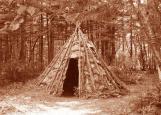1
One of the auxiliary boats used to assemble booms of logs for towing down the lake.1900
Red Indian Lake, Millertown, Newfoundland, Canada

2
A recollection of memories from Rolland Goodyear, who worked in Millertown from the start, and was there when Lewis Miller sold his interest to Newfoundland Timber Estates Company. He stayed until the departure of the Swedish workforce, who had by then, had trained the Newfoundlander's in all aspects of the operation.Rolland Goodyear, Born 1882
Roland C. Goodyear's account (first hand) of the beginning of Millertown. This account was written in the late 1950's or early 1960.
4
Not only did Lewis Miller uproot an established enterprise, which was a going concern in Sweden, and transport it complete to this part of the country which was then wilderness, but the workmen, their families, complete with household effects. It would appear that this fact alone would have been of sufficient importance to have found, recognition in our history, but as far as the public is aware, no cognizance has ever been taken of it.Plans for this pioneer work, including the building of two branch railway lines had already been made by Miller's agent, McCombie. In order to get to Red Indian Lake, a branch railway line had to be built from Joe Glode's pond to the outlet of Mary March river where it empties itself into the lake - a distance of nineteen miles. The building of the branch railway by the then government was accomplished in record time. The second was built to Little Burnt Bay, a distance of eight miles and known today as Lewisporte.
6
Besides the men and their families, the equipment brought in comprised the machinery of two Swedish sawmills complete, also the two "alligator" scows or barges. These barges were steam driven and equipped with winches of around three hundred horsepower.Besides the, logging equipment of all kinds, including some horses and oxen. In order to accommodate the families, a sufficient number of houses had to be built to take care of them. Accordingly, upwards of one hundred-two room cottages were built at the new town, including staff-house, offices etc.
Hereafter it was to be known as "Millertown". The building of the cottages started in the early summer of 1900 and by the time the Swedish families arrived, most of them were ready for occupancy. At Red Indian Lake, because of the delay of getting started due to the branch railway construction not being sufficiently far advanced to admit transportation, the majority of immigrants were detained in St. John's for almost a month and accommodation had to be found for them at boarding houses. Before winter closed in, however, accommodation of sorts had been found for most of them.
I went to Millertown in December 1900
In order to pursue the story of Millertown and the events as they occurred from here on, it is necessary for me to write in the first person. Actually at this late date, it is stimulating to me to record those events.
7
The railway water tower at Joe Glodes Pond, Millertown Junction.1900
Millertown Junction, Newfoundland, Canada

8
Train JourneyThe branch railway had just been completed from Notre Dame Junction to Little Burnt Bay (Lewisporte) and when Uncle and I arrived there, the train was ready to take passengers. We joined the main line express and arrived at the Junction of Joe Glode's Pond (Millertown Junction) on the 15th day of December, 1900 which happened to be my 18th birthday. A heavy snow storm had set in which tied up the new branch line. It required three days before the train could move, the track having to be shoveled and cleared of snow by over one hundred men. The snow had drifted in many of the open and clear places to a height of ten to fifteen feet.
9
The type of wigwam we stayed in, with the trapper Bobby Osmond.2005
Red Indian Lake, Millertown, Newfoundland, Canada

10
MaroonedUncle Sammy and I had no place to go and our small supply of food which we had brought with us had become exhausted after the first day. There was no house, no shelter of any kind and certainly no food obtainable. An old trapper by the name of Robert (Bobby) Osmond happened to have a small wigwam, which was barely large enough for himself and his needs. Bobby learned of our plight and came to the rescue. Those three days which we spent with Bobby were, I believe, amongst the toughest I ever endured up to that time.
12
Settle InThere being no passenger car, we rode in the 'flanger' which was really a boxcar. We reached Millertown that afternoon. Uncle presented his credentials at the office and we were assigned to a cottage which was equipped with a stove and wooden bunks and large enough to accommodate eight men, all of whom did their own cooking and "batched" or shacked themselves. There were no boarding houses or mess halls, and even if there were any we could not afford to pay board.
14
Winter ConstructionThe building of mills went on throughout the winter of 1900 - 1901. Luckily, the weather remained mild until early in the New Year when a sudden change took place and it became colder and very frosty. Actually the temperature dropped to 30 degrees below zero and steadily remained there for nearly three weeks, during which time we had very little snow. Something like three hundred men apart from the millwrights and foremen were employed at construction work alone, while several hundred had gone up the lake to the camps where they were engaged at cutting and/or felling trees, converting them into logs and hauling then to the lake side, rolling them into the water in the spring and towing them to the mill.



